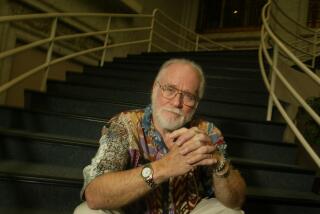Rediscovering Peter Ivers, a punk-rock Zelig with a glittering résumé and mysterious demise
Depending on where you got your info at the time, the late musician, artist and TV personality Peter Ivers was known for:
Hosting the wild early-1980s cable TV show “New Wave Theatre,” which provided early national exposure for the L.A. punk scene; making a trio of avant-garde pop albums for Warner Bros. Records; or co-writing, with director David Lynch, “In Heaven (The Lady in the Radiator Song),” a key piece for Lynch’s landmark film “Eraserhead.”
Friends with an array of boldface names including director Lynch, fellow Harvard University alums actor-director Harold Ramis and “National Lampoon” co-founder Doug Kenney, and producer-arranger Van Dyke Parks (who signed him to Warner Bros.), Ivers exuded charisma and intellect.
Tragically, though, Ivers is perhaps most noted for being the victim of a brutal unsolved 1983 murder in Little Tokyo that made the front page of The Times and has baffled LAPD detectives and true crime sleuths for decades.
Ivers is the subject of a new collection of archival music called “Becoming Peter Ivers,” which resurrects home studio recordings that showcase his curious creations and expert harmonica playing. In the process, it puts a spotlight on an artist and personality who carved a wide path through 1970s and ‘80s Los Angeles.

Five years in the making, “Becoming Peter Ivers” focuses on the songs Ivers made in 1970s Laurel Canyon when he was living with then-girlfriend Lucy Fisher. “We knew he was ahead of his time, but we didn’t realize there would ever be a time in which he was in sync with us. It could be now,” says Fisher, who relocated with Ivers to L.A. in the early 1970s and lived with him for much of the decade.
A former movie studio executive and founder (with husband Douglas Wick) of Red Wagon Entertainment, Fisher helps administer Ivers’ estate and facilitated the donation of the artists’ papers and recordings to Harvard University. In the aftermath of Ivers’ murder, she tirelessly advocated on his behalf, going so far as to hire private detective Anthony Pellicano to help close the case.
She describes Ivers’ body of work as “a rabbit hole for many people over the years. When people get obsessed with Peter, they don’t emerge for years.”
Enter Matt Werth, whose label RVNG specializes in reissuing archival experimental music. The producer and curator first heard Ivers’ music in the early ‘00s through a song called “Miraculous Weekend,” and about five years ago decided to pursue some sort of reissue project.
“It just completely scrambled my brain,” Werth said of that first musical run-in. “It was this odd, mutant pop led by this wild vocal expression, a minimal drum machine and Fender Rhodes [piano]. I was like, ‘I have to learn everything about this music and this musician.’ It all spiraled into the world of Peter.”
Fisher was skeptical when Werth approached her to discuss some sort of archival music project: “I said, ‘Matt, you seem like a terrific guy. Are you sure you want to embark on this?’”
He assured her that he did, and she appreciated Werth’s passion. “Peter has had a cult following all these years that always amazed me, because he struggled in his life to get an audience,” Fisher says, adding that the artist told her that “‘it was exhausting trying to win fans over one person at a time.’ He was very good at it, but that was a very long route.”

Werth’s research was informed by viewing archival episodes of “New Wave Theatre,” where Ivers earned his most high-profile attention. As host, his antics were beamed via the USA Network into first-generation cable boxes in the early 1980s.
The show, which was created and produced by Ed Ochs and the late David Jove, helped codify the term “new wave” for outcast teens in faraway towns across America. In its 25 episodes, the show booked free-for-all sets from L.A. punk bands including Bad Religion, Circle Jerks, 45 Grave and the Angry Samoans, with Ivers wearing ridiculous outfits and probing his guests on the meaning of life.
“I prefer to capture an event rather than manufacture it,” Ivers told The Times a year before his death. “My role is to be a provocateur. That’s why I wear glitter all the time. I know the punks hate it.”
“He was the most interesting man in Hollywood,” says Bob Forrest, former singer for post-punk band Thelonious Monster and recovery advocate who appeared on “Celebrity Rehab.” Forest was at many of those “New Wave Theatre” tapings at the Hollywood nightclub Florentine Gardens. Drugs were rampant, Forrest says. “I was too young to know, but you could feel it. ‘This is dangerous. This is chaotic. This is right up my alley.’
“You’d walk in and it’s a TV studio and there’d be bands playing right on the floor,” Forrest recalls. “No stage. There’d be all these punk rockers — homeless punk rockers, all these crazy people who were part of the Hollywood Boulevard [scene].”
Werth also consulted writer Josh Frank’s book (with Charlie Buckholtz), “In Heaven Everything Is Fine: The Unsolved Life of Peter Ivers and the Lost History of New Wave Theatre.” The 2008 book explored Ivers’ creative life, but focused more on the murder.
On the night of March 3, 1983, Ivers was found dead in his sixth floor apartment. He was 36. According to a contemporaneous account in The Times, detectives believed he “was beaten to death in his bed by a late-night intruder (or intruders) who surprised Ivers in his unlocked loft on East 3rd St. and made off with audio equipment worth a few hundred dollars.”
Word spread fast. Within a few hours, a dozen friends had converged on the loft. According to Fisher, the LAPD made little attempt to secure the apartment. “The crime scene was so polluted by the time I got there that that was very difficult,” Fisher says. She recalls her best friend at the time, the late Elizabeth Glaser, arriving at the loft with her then-husband, actor Paul Michael Glaser, who was riding high with the success of the crime drama “Starsky and Hutch.”
Fisher says a particular exchange that night between the LAPD and the erstwhile Starsky gave her pause: “The police turned to him and said, ‘What do we do?’ And he said, ‘I’m an actor!’”
For obvious reasons, the true-crime angle drew RVNG owner Werth’s interest, but his devotion to the music had already been established. He wrote Fisher a letter expressing interest in getting the rights for a reissue project. By then, she’d learned to be skeptical. She’d grown tired of the kind of pitches that had come in.
“My general tendency was to say no to most things,” she said, describing proposals that “had creepy elements to them because of the murder aspect. Matt’s was very purely about the music.”

“Becoming Peter Ivers” confirms Fisher’s intuition. A loving 21-song collection, culled from nearly 700 hours of Ivers’ home tapes, it features a few licensed studio recordings from Ivers’ Warner Bros. albums, but focuses more on intimate recordings he made in Laurel Canyon.
“Conference Call at Four” is a catchy piano- and drum-machine-driven song about a pending appointment to discuss the hit potential of the artist’s songs. The loose, rollicking “Alpha Centauri” was written for Fisher while she was out of town. When she returned, Ivers had set a tape player on her pillow with the song cued up.
Fisher was a little concerned that the project would fall on deaf ears. “I was nervous, for Peter’s sake. Who needs to be rejected again when you were rejected during your life, and now it’s 36 years later?”
Ivers first earned ink in The Times when he performed as part of the Hollywood Street Revival and Trash Dance at the Hollywood Palladium on a bill that including Iggy Pop, protopunk band the New York Dolls and self-described groupie band the GTOs.
Two years later he opened for his Warner Bros. labelmate Fleetwood Mac, which at the time was hitting peak popularity with the success of “Rumours.” As an incitement, Fisher recalls, Ivers performed in a diaper. The crowd wasn’t impressed, and a chorus of boos spread through the crowd.
“That was really pretty horrible,” she recalls. “I was sitting in the front, and I remember standing and screaming, ‘Shut up! Listen!’ to 3,000 people booing.”
In fact, Ivers had started reaping financial and creative rewards for his work before his death. In early 1983, Diana Ross recorded “Let’s Go Up,” a song Ivers co-wrote with Franne Gold. Phyllis Hyman and Michael Henderson performed a slow-burning duet of Ivers’ “Can’t We Fall in Love Again.”
He’d also started composing grander projects. “City of Tomorrow,” a musical film that was in development at Warner Bros. at the time of his death, was to be set in “a barbaric world of the future” and follow “a group of idealistic teenagers who set out to fight the powers-that-be and save society.”
Ivers’ murder is now an LAPD cold-case file, and Fisher has accepted that closure might never come. Asked if she thought Ivers was killed by someone he knew, she says she’s “spent many years pondering that question.”
“I do think it’s possible that it was somebody crazy that he knew,” she adds. “But I think it was also possible it was a passer-by who had heard music coming out of there and knew. Equipment was stolen and the door was not locked. [Peter] could do everything except lock a door, basically.”
More to Read
The biggest entertainment stories
Get our big stories about Hollywood, film, television, music, arts, culture and more right in your inbox as soon as they publish.
You may occasionally receive promotional content from the Los Angeles Times.







